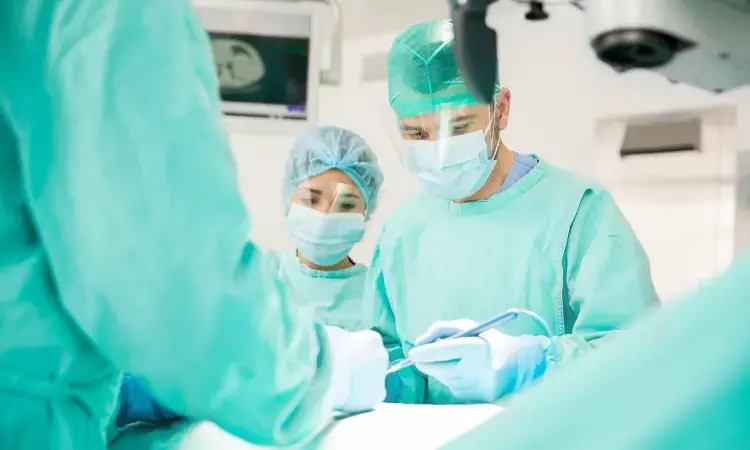- Home
- Medical news & Guidelines
- Anesthesiology
- Cardiology and CTVS
- Critical Care
- Dentistry
- Dermatology
- Diabetes and Endocrinology
- ENT
- Gastroenterology
- Medicine
- Nephrology
- Neurology
- Obstretics-Gynaecology
- Oncology
- Ophthalmology
- Orthopaedics
- Pediatrics-Neonatology
- Psychiatry
- Pulmonology
- Radiology
- Surgery
- Urology
- Laboratory Medicine
- Diet
- Nursing
- Paramedical
- Physiotherapy
- Health news
- Fact Check
- Bone Health Fact Check
- Brain Health Fact Check
- Cancer Related Fact Check
- Child Care Fact Check
- Dental and oral health fact check
- Diabetes and metabolic health fact check
- Diet and Nutrition Fact Check
- Eye and ENT Care Fact Check
- Fitness fact check
- Gut health fact check
- Heart health fact check
- Kidney health fact check
- Medical education fact check
- Men's health fact check
- Respiratory fact check
- Skin and hair care fact check
- Vaccine and Immunization fact check
- Women's health fact check
- AYUSH
- State News
- Andaman and Nicobar Islands
- Andhra Pradesh
- Arunachal Pradesh
- Assam
- Bihar
- Chandigarh
- Chattisgarh
- Dadra and Nagar Haveli
- Daman and Diu
- Delhi
- Goa
- Gujarat
- Haryana
- Himachal Pradesh
- Jammu & Kashmir
- Jharkhand
- Karnataka
- Kerala
- Ladakh
- Lakshadweep
- Madhya Pradesh
- Maharashtra
- Manipur
- Meghalaya
- Mizoram
- Nagaland
- Odisha
- Puducherry
- Punjab
- Rajasthan
- Sikkim
- Tamil Nadu
- Telangana
- Tripura
- Uttar Pradesh
- Uttrakhand
- West Bengal
- Medical Education
- Industry
Doctors at Narayana Health perform world's 1st keyhole cardiac surgery on Bangladeshi man with dextrocardia

Bangalore: A team of doctors in Bengaluru has successfully performed the world's first minimally invasive (keyhole) cardiac surgery on a Bangladeshi man with a heart on the right side of his chest, called dextrocardia, instead of the normal left.
Dextrocardia is a rare congenital heart defect, in which the heart is in an abnormal position in the chest. It occurs in 1 in 10,000 people.
The patient Yeashin Bhuiyan, 47, was suffering from complex triple vessel disease -- an extreme form of coronary artery disease (CAD), which happens when coronary arteries struggle to supply the heart with enough blood, oxygen and nutrients.
Bhuiyan successfully underwent coronary artery bypass surgery (CABG) at Narayana Health City, Bengaluru, where doctors performed the procedure by making a small incision on the right side of the chest, making this the first of its kind ever performed in the world.
“We achieved a groundbreaking milestone in cardiac surgery by performing the world's first minimally invasive procedure on a right-side heart. The surgery's challenging nature was due to the shift from the usual left-side approach to performing it from the right side. This necessitated significant modifications to instruments and techniques,” Dr Raghu M. G., Senior Cardiac surgeon, Narayana Health City, Bangalore, told IANS.
“The team achieved this impressive feat by making a small incision of just five centimetres on the right side of the chest, delicately manoeuvring through the ribs to access the heart without any bone cuts. The procedure involved bypassing all blocked arteries caused by coronary artery disease and was performed on a beating heart, ensuring minimal disruption,” he added.
Bhuiyan, a diabetic has been having exertion-induced pain on the right side of his chest for about six months. A chest X-ray revealed dextrocardia, and then the clinical symptoms coincided with the cardiac origin of the disease.
The procedure was performed on June 16 and Bhuiyan was removed from the ventilator within four hours and discharged within five days, Dr. Raghu told IANS, noting that “the patient's recovery was impressive”.
While the exact cause of dextrocardia is unknown, gene defects passed down through families are majorly responsible. In most people with dextrocardia, other organs in the chest and abdomen are also reversed. These include the lungs, stomach, liver, and spleen. If the heart and other organs are in a reversed or "mirror image" position, this is called dextrocardia with situs inversus.
Dextrocardia with situs inversus is associated with less than 10 per cent of cardiac abnormalities and has shown almost similar frequency to the normal population in terms of coronary artery disease.
The incidence of CAD in patients with dextrocardia is not well-established, but it is thought to be higher than in the general population.
Medical Dialogues Bureau consists of a team of passionate medical/scientific writers, led by doctors and healthcare researchers. Our team efforts to bring you updated and timely news about the important happenings of the medical and healthcare sector. Our editorial team can be reached at editorial@medicaldialogues.in.


